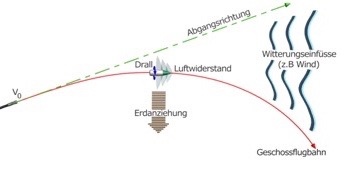Shooting theory 1
- Engelhardt
- 31. December 2018
- 17:38

This post starts a small series on biathlon shooting theory as part of biathlon shooting technique. Basic knowledge of shooting theory is a prerequisite for learning the biathlon shooting technique. They help the athlete to understand their own actions in training and competition and thus to apply them more properly.
Unfortunately, the knowledge of biathlon shooting technique is often criminally neglected in the training of young athletes. With this and the following contributions I would like to contribute to the fact that this is no longer the case in the future.
Principles
Shooting theory includes:
- The doctrine of the shot,
- The sighting device and aiming,
- The scattering, the impact pattern and the bullet effect
- Determining the initial values and shot corrections.
In this article, first of all, the doctrine of the shot will be presented.
Doctrine of the shot
The Doctrine of the shot describes the theoretical basics of shooting. It includes the Interior ballistics, the Barrel front ballistics (Also called intermediate or transition ballistics, examines the movement of the projectiles and related processes at the Muzzle and in their immediate vicinity. It is not considered further within the scope of this document.), the Exterior ballistics as well as the Target ballistics.
The Shooting theory altogether represents the practical application of the subdisciplines Interior ballistics, Exterior ballistics as well as Target ballistics and enables the derivation of principles for the biathlon shooting technique.
The Interior ballistics describes the movement of the bullet in the barrel after ignition of the propellant charge from the chamber to the muzzle.
In all biathlon rifles, the firing pin strikes the priming rim of the cartridge and ignites the propellant charge via the priming charge. When the propellant charge burns, gases are produced which propel the bullet through the barrel under strong pressure (Does not apply to the air rifles used in the student class. Here, the pressure necessary to accelerate the projectile (diabolo) is provided by compressed air). This causes the projectile to move forward with rapidly increasing velocity. The velocity is essentially dependent on
- of the propellant charge (strength of the pressure),
- the bullet (material, weight) and
- the length and nature of the barrel.
Into the barrel are threaded rifling cut into the bullet. The protruding parts, the lands, give the bullet a rotation (twist) to the right around its longitudinal axis.
The Exterior ballistics describes the bullet trajectory from leaving the muzzle to hitting the target.
Basic knowledge of the factors that influence bullet trajectory is a prerequisite for accurate shooting. The athletes thereby learn to detect deviations from normal shooting conditions and to take them into account when making shot corrections.
The bullet trajectory is mainly influenced by the following factors:
- Departure direction (by side and height),
- Initial velocity of the projectile (V0),
- Earth's gravitational force,
- Twist,
- Air resistance as well as
- other weather influences.
The Departure direction is the direction of flight of the projectile as it leaves the barrel.
The Initial velocity describes the velocity of the bullet 1 m after leaving the muzzle. It is measured in m/s. The velocity of the projectile constantly decreases during the further flight. The curvature of the trajectory depends essentially on the initial velocity. The higher the initial velocity, the more elongated the trajectory of the projectile.
The Earth's gravitational force, of the earth always acts in the direction of the center of the earth and thus "pulls" the projectile toward the surface of the earth.
Due to the Twist the projectile is stabilized in its longitudinal axis so that it does not roll over.
The Air resistance reduces the velocity of the projectile.
With the other weather influences are wind, temperature, air pressure and precipitation. Heavy precipitation slows down the projectile and crosswind causes lateral deviation.
The interaction of the constant reduction of the initial velocity due to air resistance and the gravitational pull of the earth causes the characteristic curvature of the trajectory, since all factors change permanently in the course of the projectile flight.

The Target ballistics describes the Effect of the projectile in the target. Knowledge of target ballistics is necessary to understand how hits occur in the various targets used, as well as to be aware of the possible consequences of firing according to the four basic safety rules.
When firing the following occur in principle Side effects on:
- Muzzle flash (residual powder gases still burning),
- Muzzle blast (powder gases coming out behind the projectile in a shock-like manner at the muzzle of the barrel),
- Projectile bang (air wave from projectiles whose velocity is greater than the speed of sound) and
- Recoil.
In the case of the ammunition used in biathlon shooting, these side effects are to be classified as rather low or are completely absent (e.g. bullet bang).